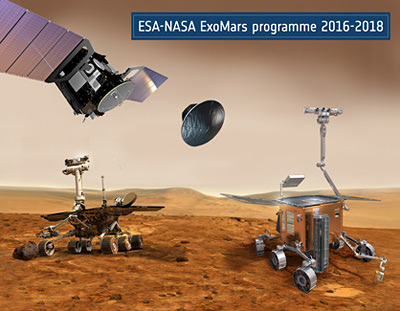[/caption]
From a NASA press release:
NASA and the European Space Agency (ESA) are working on a joint program to explore Mars in the coming decades and announced today they have selected five science instruments for the first mission. The ExoMars Trace Gas Orbiter, scheduled to launch in 2016, is the first of three joint robotic missions to the Red Planet. It will study the chemical makeup of the Martian atmosphere with a 1000-fold increase in sensitivity over previous Mars orbiters. The mission will focus on trace gases, including methane, which could be potentially geochemical or biological in origin and be indicators for the existence of life on Mars. The mission also will serve as an additional communications relay for Mars surface missions beginning in 2018.
“Independently, NASA and ESA have made amazing discoveries up to this point,” said Ed Weiler, associate administrator of NASA’s Science Mission Directorate in Washington. “Working together, we’ll reduce duplication of effort, expand our capabilities and see results neither ever could have achieved alone.”
The selection of the instruments begins the first phase of the new NASA-ESA alliance for future ventures to Mars. The instruments and the principal investigators are:
— Mars Atmosphere Trace Molecule Occultation Spectrometer — A spectrometer designed to detect very low concentrations of the molecular components of the Martian atmosphere: Paul Wennberg, California Institute of Technology, Pasadena Calif.
— High Resolution Solar Occultation and Nadir Spectrometer — A spectrometer designed to detect traces of the components of the Martian atmosphere and to map where they are on the surface: Ann C. Vandaele, Belgian Institute for Space Aeronomy, Brussels, Belgium.
— ExoMars Climate Sounder — An infrared radiometer that provides daily global data on dust, water vapor and other materials to provide the context for data analysis from the spectrometers: John Schofield, NASA’s Jet Propulsion Laboratory (JPL), Pasadena, Calif.
— High Resolution Color Stereo Imager — A camera that provides four-color stereo imaging at a resolution of two million pixels over an 8.5 km swath: Alfred McEwen, University of Arizona.
— Mars Atmospheric Global Imaging Experiment — A wide-angle, multi-spectral camera to provide global images of Mars in support of the other instruments: Bruce Cantor, Malin Space Science Systems, San Diego, Calif.
The science teams on all the instruments have broad international participation from Europe and the United States, with important hardware contributions from Canada and Switzerland.
“To fully explore Mars, we want to marshal all the talents we can on Earth,” said David Southwood, ESA director for Science and Robotic Exploration. “Now NASA and ESA are combining forces for the joint ExoMars Trace Gas Orbiter mission. Mapping methane allows us to investigate further that most important of questions: Is Mars a living planet, and if not, can or will it become so in the future?”
The plan consists of two Mars cooperative missions in 2016 and 2018, and a later joint sample return mission. The 2016 mission features the European-built ExoMars Trace Gas Orbiter, a European-built small lander demonstrator, a primarily-U.S. international science payload, and NASA-provided launch vehicle and communications components. ESA member states will provide additional instrument support.
The 2018 mission consists of a European rover with a drilling capability, a NASA rover capable of caching selected samples for potential future return to Earth, a NASA landing system, and a NASA launch vehicle. These activities are designed to serve as the foundation of a cooperative program to increase science returns and move the agencies toward a joint Mars sample return mission in the 2020s.


Yay! I look forward to the methane results, as they should confirm that Mars is still geologically active. That would rise expectations on finding current or even fossil life.
Also, seeing that there is still a matter of pride (I guess) european lander, I guess “reduce duplication” is the best description. Remove duplication would have been to good to hope for.
Nice. Some very worthy instrumentation by the sounds of it.
Damn it all – I’ve got to stop wishing my life away looking forward to these missions!
Time for a global space agency, surely?
2016 – 2018??????? This sounds very exciting, but I can’t wait that long! I want to know more about Mars NOW!!!!